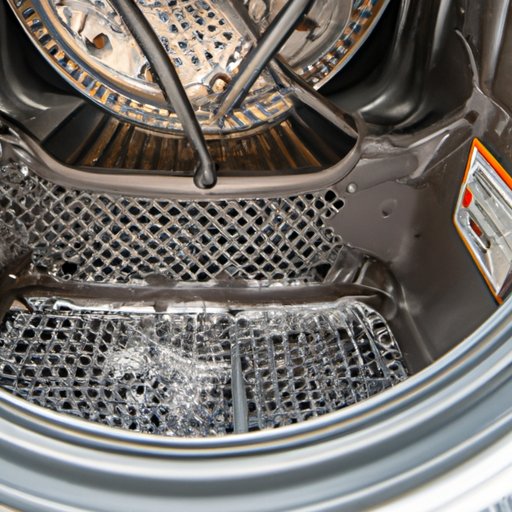Introduction
Front load washers have become increasingly popular in recent years, thanks to their efficiency and effectiveness in cleaning clothes. However, one of the most common issues with these machines is how to clean them. Mold and mildew can build up inside the washer drum and door seal, causing unpleasant odors and potential health problems. This article will provide a detailed guide on how to clean a front load washer, tips for preventing mold and mildew, and recommended cleaning products.
How to Clean a Front Load Washer
Before starting, gather the following materials:
- White vinegar
- Baking soda
- Hot water
- Microfiber cloth
- Toothbrush or small scrub brush
Follow these steps to clean the interior of the washer:
- Fill the detergent dispenser with 2 cups of white vinegar.
- Run the washer on the hottest cycle, using the highest water level and an extra rinse if possible. This will help to remove any buildup of detergent or fabric softener.
- After the cycle is complete, sprinkle 1 cup of baking soda inside the washer drum.
- Run another hot cycle, using the same settings as before.
- Once the cycle is complete, use the microfiber cloth to wipe down the interior of the washer and the door seal. Be sure to get into all the nooks and crannies, including the gasket around the door.
- If there are any areas with stubborn stains or buildup, use the toothbrush or small scrub brush to gently scrub them away.
After cleaning the interior, wipe down the exterior of the washer with a damp microfiber cloth. Pay particular attention to areas that are frequently touched, such as the detergent dispenser and control panel.
The Benefits of Maintaining a Clean Front Load Washer
Regular cleaning of your front load washer offers several benefits:
- Improved performance: A clean washer will work more efficiently and effectively, resulting in cleaner clothes and less stress on the machine.
- Increased lifespan: Proper maintenance can extend the lifespan of your washer, saving you money in the long run.
- Fewer repairs and maintenance issues: By preventing buildup and addressing issues early on, you can reduce the likelihood of needing costly repairs and frequent maintenance.
Tips for Preventing Mold and Mildew Buildup in Front Load Washers
In addition to regular cleaning, there are several steps you can take to prevent mold and mildew from building up in your front load washer:
- Leave the door open: After each use, leave the washer door open to allow air to circulate and the moisture to evaporate. This will prevent mold and mildew from growing inside the machine.
- Use specialized cleaning products: There are several cleaning products specifically designed for front load washers that can help prevent mold and mildew. Look for products that contain bleach or peroxide, which are effective at killing bacteria and eliminating odors.
- Avoid leaving wet laundry: Try not to leave wet laundry in the machine for extended periods of time. As soon as the cycle is complete, remove the clothes and dry them as soon as possible.
- Use hot water and bleach: Run a hot cycle with bleach or peroxide at least once a month to keep the washer clean and fresh.
Recommended Cleaning Products for Front Load Washers
There are many effective cleaning products for front load washers, including both natural and store-bought options:
- Vinegar: White vinegar is a natural cleaner that can be used to remove buildup and odors. Simply add 1-2 cups of vinegar to the detergent dispenser and run a hot cycle.
- Baking soda: Baking soda can be used in place of or in addition to vinegar to further remove buildup and odors. Sprinkle 1-2 cups of baking soda into the washer drum before running a hot cycle.
- Affresh: Affresh is a popular store-bought cleaner specifically designed for front load washers. It comes in tablet form and is easy to use. Simply add one tablet to the detergent dispenser and run a hot cycle.
- Tide Washing Machine Cleaner: Tide offers a washing machine cleaner that is effective at removing buildup and stains. It comes in a powder form that can be added to the washer drum before running a hot cycle.
- Clorox Washing Machine Cleaner: Clorox also offers a washing machine cleaner that is effective at removing mold, mildew, and odor-causing bacteria. It comes in a bottle and can be used once a month to keep your washer clean and fresh.
Troubleshooting Common Issues with Front Load Washers
If you are experiencing any of the following issues, try these troubleshooting tips:
- Unpleasant odors: Run a hot cycle with 1-2 cups of white vinegar or baking soda. This will help to remove any buildup of bacteria or mold.
- Excessive water usage: Check the water supply hoses for any kinks or leaks. Make sure that the hoses are securely attached to the machine and the water supply. If the problem persists, it may be a mechanical issue that requires professional assistance.
- Clothes not getting clean: Make sure that you are using the correct amount of detergent and that the detergent is appropriate for your machine. Try running a hot cycle with a washing machine cleaner to remove any buildup that may be affecting the machine’s performance.
- Washer not draining properly: Check the drainage hose for any kinks or clogs. Make sure that the hose is securely attached to the machine and the drainage pipe. If the problem persists, it may be a mechanical issue that requires professional assistance.
Conclusion
A clean front load washer is essential for optimal performance and a long lifespan. Regular cleaning, preventative measures, and the use of effective cleaning products can help to prevent mold and mildew buildup and ensure that your washer is working at its best. By following the step-by-step guide and tips in this article, you can keep your front load washer fresh, clean, and running smoothly for years to come.
